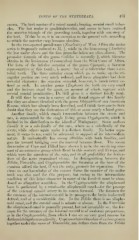Page 447 - My FlipBook
P. 447
TEETH OF THE VERTEBRATA. 457
crown. The heel consists of a raised margin bearing several small tuber-
cles. The last molar is quadritubercular, and seems to have retained
the anterior triangle of the preceding tooth, together with one cusp of
the heel. If this be so, it is an exception to the general rule, according
to which the anterior cusp becomes obsolete.
In the two-spotted paradoxure [Nandinia) of West Africa the molar
series is frequently reduced to M. ^, while in the bintourong {Arctkiis)
the last molar above and the first })remolar below are often absent. The
premolar formula of the genus GaUdea is normally f , which likewise
obtains in the kusimanse (Crosscn-chiisi) from the West Coast of Africa.
The form of the inferior sectorial of the genus Ctjiio(/a/e, a Bornean
representative of this family, is nearer that of a tubercular than a sec-
torial tooth. The three anterior cusps which go to make up the tri-
angular portion are very much reduced, and have altogether lost their
sectorial character ; the superior sectorial, however, is much better de-
fined as such. In another genus (^Eaph'rcx) the teeth are very small
and the incisors stand far apart, on account of which, together with
several cranial peculiarities, Dr. Gill gives it a distinct family rank.
It will thus be seen in a survey of the dental organs of this family
that they are almost identical with the genus Didymictis of our American
Eocene, which has already been described, and I think there can be little
doubt that they are the derivatives of this or some nearly related genus.
Another family, which stands intermediate between the civets and
cats, is represented by the single living genus Ci')jptoprocta,^\\\\Q\\ is
limited in its distribution to the island of Madagascar. Some authors
classify it as a sub-family of the cats, others as a sub-family of the
civets, while others again make it a distinct family. No better argu-
ment, it seems to me, could be advanced in support of its intermediate
nature. It undoubtedly has strong affinities with l)oth families, and
goes far toward bridging over the interval between them. The recent
discoveries of Cope and Filliol have shown it to be the surviving rem-
nant of an extensive group which lived in this country and Euro]:)e, and
which were the ancestors of the cats, and in all probability the deriva-
tives of the more generalized civets. In distinguishing between the
Feddee, Viverridre, and Cri/pfoproctidce. the foramina at the base of the
cranium afford the best, if not the only, grounds for separation. Pre-
vious to our knowledge of the extinct forms the number of the molar
teeth was also used for this purpose, but owing to the intermediate
condition of this latter character in many of the fossils it must be aban-
doned as altogether worthless. In the Crypfojyrodldcv the alisphenoid
bone is perforated by a canal—the alisphenoid canal—for the passage
of the external carotid artery in its course forward. The foramen for
the entrance of the internal carotid in its passage to the brain is also well
defined, and of a considerable size. In the Felidce there is no alisphe-
noid canal, and the carotid canal is minute or absent. In the Viverridce
the alisphenoid canal is generally present, but not invariably so ; the for-
amen for the entrance of the internal carotid is of moderate proportions,
as in the Cryptoproctidce, from which I can see no very good reasons for
distinguishing them as a family. Cope associates a number of extinct genera
together under the name of Nhnravidce, and defines them from the Felidce


